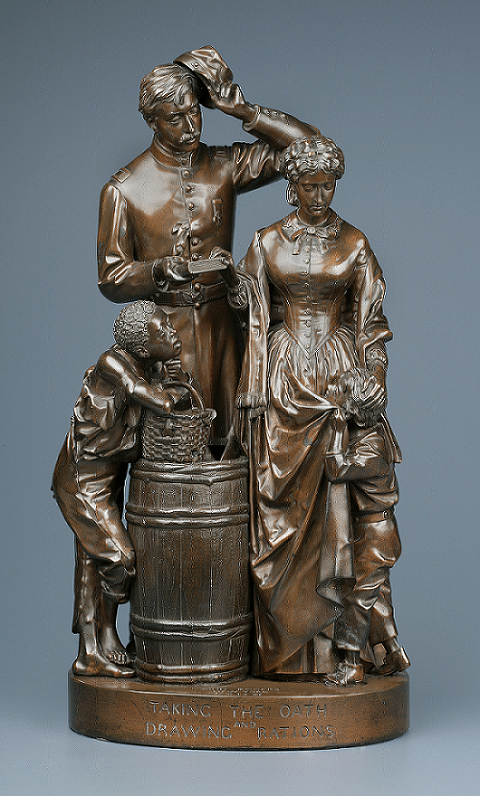Document Text |
Summary |
| State of Missouri County of St. Louis |
|
| I, M. Dunn Teacher in the Benton School, do solemnly swear that I will support, protect, and defend the Constitution of the United States and the Constitution of the State of Missouri, against all enemies and opposers, whether Domestic or Foreign; that I will bear truth faith, loyalty, and allegiance to the United States, and will not, directly or indirectly, adhere to the enemies or opposers thereof, or of the Provisional Government of the State of Missouri, by giving them aid and comfort, any ordinance, law, or resolution of any State Convention or Legislature, or of any order or organization, secret or otherwise, to the contrary notwithstanding; and that I do this with a full and honest determination, pledge and purpose to keep and perform the same, without any mental reservation or evasion whatever: So help me God. | I, Margaret Dunn, swear to remain loyal to the United States and the Provisional Government of Missouri. I will not work with the enemies of the United States or Missouri, or give them any kind of help. I am honest and determined to stay loyal. |
| Subscribed and sworn to, before me, at the city of St. Louis, this the 13th day of September, 1862. Margaret Dunn |
|
| Witness my hand and official seal the date aforesaid. Ferd. Gothchalk, notary public |
Loyalty oath of Margaret Dunn of Missouri, County of St. Louis, transcription, September 23, 1862. Missouri Historical Society.
Background
When Union troops took control of Confederate territory, the residents had to take a loyalty oath promising to uphold the U.S. Constitution and government. In return, they were allowed to keep their homes and land, travel, get protection from the U.S. Army, and receive rations and support from the U.S. government.
Loyalty oaths were most commonly required of former soldiers, but thousands of Confederate women took the oaths to protect their homes, families, and livelihoods. By the end of the war, these oaths came to symbolize the possibility of reconciliation.
About the Document
The first item in this pair of sources is a loyalty oath signed by Margaret Dunn in Missouri in 1862. Missouri was a border state, but tens of thousands of Missourians supported and fought for the Confederacy. Loyalty oaths varied from region to region because different commanding officers determined the phrasing and demands of the oaths.
The second item is a sculpture by artist John Rogers. He sculpted this scene, entitled Taking the Oath and Drawing Rations, seven months after the end of the Civil War. It uses the well-known practice of taking loyalty oaths to represent the daunting task of reuniting the Union and Confederacy. A genteel white woman and her young child represent the Confederacy. They have come to take the oath in order to receive rations they need. Rogers used a woman and child because he knew they would evoke sympathy. An officer taking off his cap, a sign of respect, represents the Union. He will administer the loyalty oath. A Black child looks on. He has come with the white family and holds the basket that will be filled with rations after the oath.
This sculpture struck a chord with white Americans in the post-war era. John Rogers sold so many copies that his workshop could not keep up with the demand. The sculpture came to be considered his masterpiece, and it was one of only two Civil War-themed sculptures that he continued to sell until his retirement in 1892.
Vocabulary
- border state: The slave-holding states in the Union that shared a border with the Confederacy.
- Confederate: Relating to the group of states that seceded from the United States before the Civil War in order to preserve slavery.
- genteel: Respectable and refined.
- rations: Supplies of food, clothing, or other daily necessities.
- Union: The name for the states that remained a part of the United State during the Civil War.
Discussion Questions
- What does the loyalty oath demand of oath takers? Why were these demands a priority for occupying forces?
- Why was the practice of Confederate women taking loyalty oaths so evocative for American viewers?
- How does Rogers’ sculpture compare to the realities of the Civil War and Reconstruction?
- What does the popularity of this sculpture tell us about attitudes towards reconciliation in the Reconstruction period?
Suggested Activities
- Use these sources in any lesson about the U.S. government’s attempt to repatriate Confederate supporters during and after the Civil War.
- Ask students to critique the historical accuracy in Rogers’ sculpture and suggest changes that would more accurately reflect reconciliation.
- To help students understand why the U.S. government required Confederate women to take loyalty oaths, pair these sources with Changing the Rules of War.
- To learn more about the experiences of Confederate women during Reconstruction, read the life story of Ella Gertrude Clanton Thomas.
- For more information about how women were used as symbols in both Union and Confederate artwork, see the following: Scenes from the Confederate Homefront, Civil War Political Cartoons, and Nursing.
- To complicate the prevailing stereotype of the genteel Confederate woman depicted in John Roger’s sculpture, explore any of the following: Women Soldiers, Smuggling, Changing the Rules of War, Civil War Political Cartoons, Life Story: Emily Jane Liles Harris, Life Story: Loreta Janeta Velázquez.
Themes
AMERICAN IDENTITY AND CITIZENSHIP








